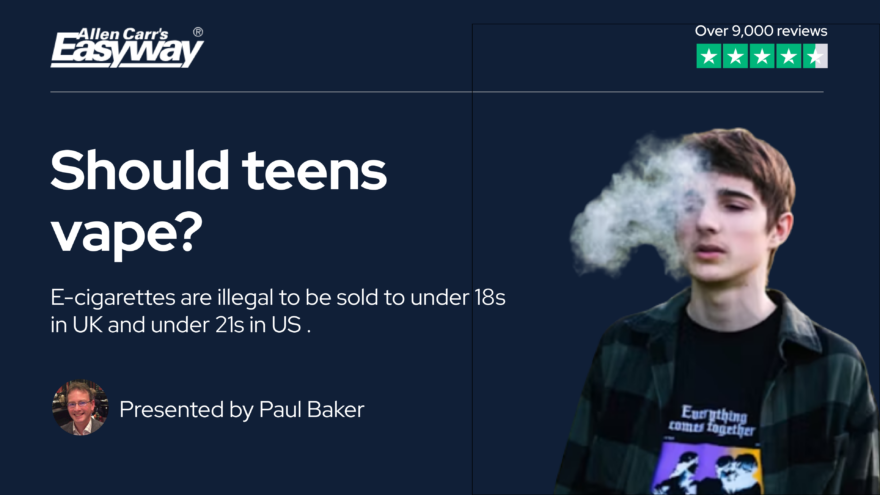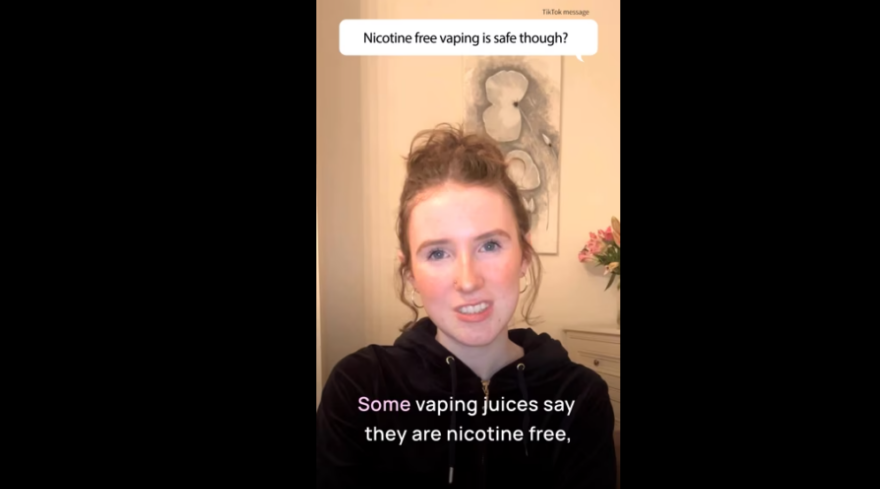Should teens vape?
E-cigarettes are illegal to be sold to under 18s in UK and under 21s in US but they can be ordered online so they are readily available as are the vaping liquids or juices.

What’s stopping you?
Not sure if you’re ready to stop smoking? Worried about finding it difficult?
Start the quizE-cigarettes are illegal to be sold to under 18s in UK and under 21s in US but they can be ordered online, so for a youngster with access to your credit card or, if they are old enough their own card, they are readily available as are the vaping liquids or juices.
Sadly, there are many retail outlets that sell to teens in spite of the law and also a thriving black market amongst teens in classrooms across the country.
E-cigarettes very often contain nicotine in the juice, and those that do not are often a gateway to the nicotine variety.
In fact 99% of the e-cigarettes sold in the USA contained nicotine and according to JUUL’s website, the nicotine content of one JUULpod is equivalent to one packet of cigarettes.
Nicotine exposure in adolescents can harm brain development such as those parts that control attention, learning, mood and impulse control and may affect mental health.
Nicotine is a highly addictive substance and in fact it has been reported to be harder to quit than cocaine.
Adolescents are more susceptible to addiction than adults because their brains are still developing. It may also increase the risk for future addiction to other drugs.
It is therefore important to help them to stop vaping cartridges with flavouring, if only so that they do not move on to nicotine flavours and the challenges of becoming free from nicotine addiction.
In January 2018, the National Academies of Science, Engineering and Medicine released a consensus study report that reviewed over 800 different studies and concluded that e-cigarettes [vaping] cause health risks.
A recent study by the CDC, or Centers for Disease Control and Prevention, (national public health institute in the United States) reveals that in the USA approximately 47% of children who have tried e-cigarettes have become addicted.
Nicotine free vaping is safe though isn’t it?
Some vaping liquids or juices are sold as nicotine free however research has shown that these often contain nicotine.
Nicotine is highly addictive and even if the juice did not contain nicotine the liquids contain chemicals which can be harmful. See what’s in vaping liquid
What is in vaping liquid?
Vaping liquid / juice contains around 80 different chemicals.
Not one of the four main ingredients in vapes (propylene glycol, vegetable glycerin, nicotine and any number of different flavourings) are designed to be breathed into your lungs.
-
Flavourings
There are thousands of flavours all with different additives and chemicals.
One that was used until recently was diacetyl. This is used to create a buttery flavour such as used in popcorn, custard and sweet dessert flavours.
High levels of exposure to diacetyl can lead to the serious lung disease bronchiolitis obliterans also known as “popcorn lung”
It is banned in the UK, US & EU but is still available in flavours in the rest of the world
-
Propylene Glycol (PG)
This is used to create artificial smoke and fog on stage and on screen.
It is also an ingredient in antifreeze and is known to cause irritation to the lungs and eyes and may cause issues for people with asthma and emphysema.
Pregnant women are at risk of developing toxicity if they are exposed to large amounts of PG because they have lower levels of alcohol dehydrogenase, an enzyme that is needed to breakdown PG
-
Glycerin
It is used to add sweetness and although it is used in junk foods, soaps, medicines and skin products – you’ve guessed it – it isn’t designed to be inhaled into your lungs and causes tremendous damage.
What is in vaping vapour when heated?
-
Ultrafine particles
These can be inhaled deep into the lungs and may exacerbate conditions such as asthma and emphysema and could lead to a heart attack
-
Volatile organic compounds
These are created as a by product of heating the vapour and can cause eye, nose and throat irritation, headaches and nausea, and can damage the liver, kidney and nervous system
-
Cancer causing toxins
These include Acetaldehyde (MS), Benzene (SS), Cadmium (MS), Formaldehyde (MS,SS), Isoprene (SS), Lead (MS), Nickel (MS), Nicotine (MS, SS), N- Nitrosonornicotine (MS, SS), Toluene (MS, SS)
-
Propylene Glycol (PG)
Research has shown that heating propylene glycol changes its chemical composition, producing small amounts of propylene oxide, a known cancerous toxin.
-
Heavy metals
These are known to cause respiratory distress and disease and include nickel, tin and lead.
Read more about the side effects of nicotine vaping.
Police warn schools, parents, and kids about vapes
In 2024, the Police wrote to parents in London on two occasions warning about the risks of vaping after young people were hospitalised after vaping.
The letters stated the dangers of vaping, particularly to young people whose lungs and brain are still developing.
They also highlighted that normal vapes have not been tested medically to determine either short-term or long-term effects on the health of users, but in addition some vapes have been found to contain dangerous and addictive drugs such as ‘spice’ and high levels of THC, the psychoactive chemical found in cannabis.
Read more on Police warn about effects of vaping.
Why wait to quit vaping?
Our online video programme is tailored for teens, offering a powerful and supportive way to stop for good.
Buy now for just US$10Free Online Quiz
Not sure if you really want to quit vaping?
Need help to stop vaping?
Want to stop, but concerned that you’ll find it tough?
Worried that you’ll be deprived for the rest of your life without vapes?
We can help you to understand and remove those fears and in so doing, make it quitting easy.






